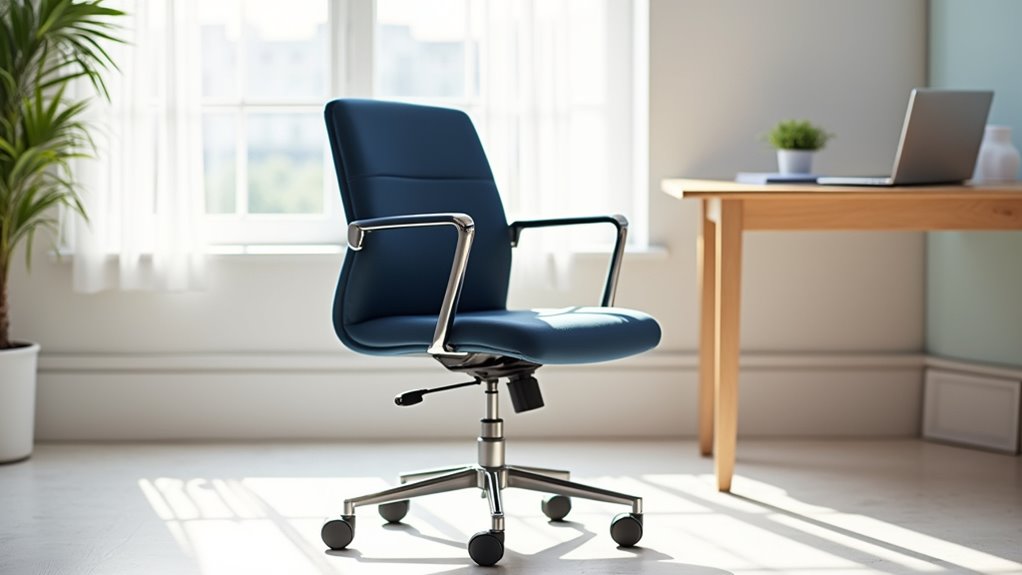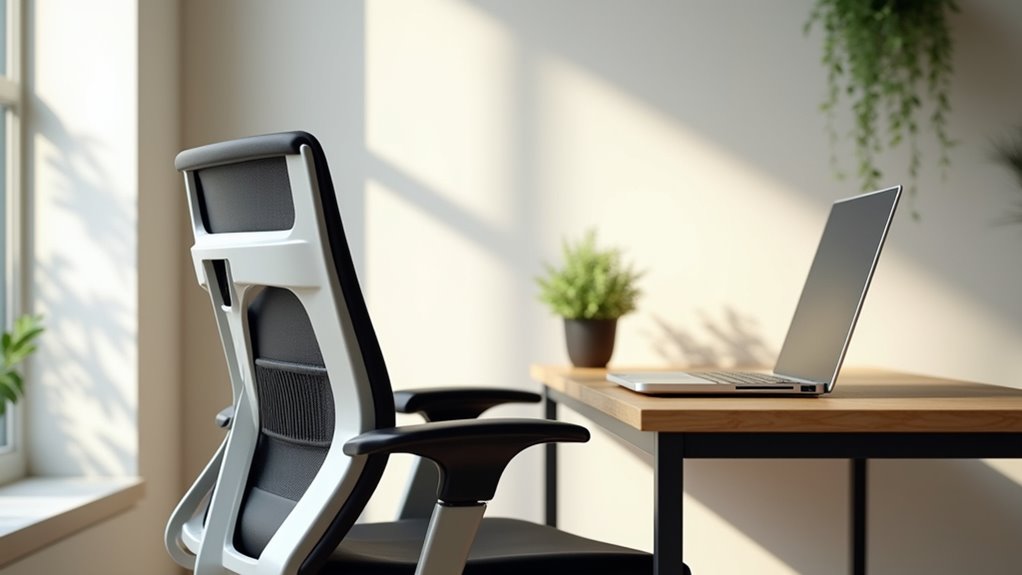How to Sit Correctly on a Chair
This post contains affiliate links. As an Amazon Associate, we earn from qualifying purchases.
To sit correctly on a chair, adjust the height so your feet are flat on the floor and your knees are bent at about a 90-degree angle. Ensure your back is supported by the chair to maintain the natural curve of your spine, which is essential for comfort and health. Keep your shoulders relaxed and your arms at a comfortable angle. For those interested in a deeper understanding of proper sitting posture, further details will follow in the article.
Essential Facts in 30 Seconds
- Adjust chair height for flat feet and knees at 90 degrees.
- Maintain a 2 to 4-inch gap between seat edge and back of knees.
- Use a chair with lumbar support that matches your lower back curve.
- Position armrests so elbows bend at 90-120 degrees.
- Keep head and neck neutral, with eyes level to the monitor.
Seat Height and Leg Position
Finding the right seat height and leg position is crucial for comfort. A good chair helps you sit well. For people around 5’3″ to 5’6″, a seat height of 16 to 18 inches works best.
Sit down and check your knees. They should bend at about 90 degrees. Keep your feet flat on the floor. No dangling feet! This helps blood flow and promotes good circulation. Maintaining a straight posture is essential for reducing discomfort during long sitting periods. Proper chair height can prevent strain on your back and legs over time.
Your thighs need to be parallel to the ground. Adjust your chair as needed. If your knees feel squished, change the seat height. Ergonomically designed chairs typically aim to ensure proper posture for comfort. Happy legs mean happy sitting!
Sometimes, a footrest can help. It gives your feet a place to rest. Enjoy your comfortable, ergonomic setup!
Seat Depth and Thigh Support

Seat depth matters a lot for comfort. A good fit means about 2 to 4 inches between the edge of the seat and the back of your knees. This space helps your thighs feel supported. You can relax without feeling squished. A proper seat depth allows for full contact with the backrest, making long sitting much more comfortable. No one likes numb legs! Additionally, ensuring proper back support is crucial to maintain spine alignment during prolonged sitting. Proper sitting posture is essential for reducing the risk of discomfort and pain. Choosing a chair with lumbar support can further enhance your sitting experience. Choose a seat that fits your body well for the best experience. Comfort is key for work or play.
Optimal Seat Depth
Finding the right seat depth is important for comfort. A small change can make a big difference. Here’s how to measure it:
- Sit Upright: Your back should touch the backrest for an accurate measurement.
- Measure Thigh Length: Measure from your hips to about 2 inches behind your knee.
- Check the Gap: There should be a 2–4 inch space behind your knees. This proper seat depth helps maintain proper posture and prevents discomfort during long periods of sitting. Additionally, proper positioning can impact overall well-being by reducing strain on muscles and joints. A well-adjusted chair height can significantly enhance overall comfort while sitting.
A good seat depth supports proper posture and keeps your spine healthy and feels great.
Take time to adjust it properly. Your body will appreciate it! Sitting can be comfortable and enjoyable.
Thigh Support Importance
Thigh support is crucial too! Good thigh support spreads your body weight evenly. This helps relieve pressure on sensitive areas. It keeps your thighs comfy and prevents discomfort or pressure ulcers. Proper seat depth adjustment is essential to ensure optimal thigh support. Additionally, ensuring your chair has proper cushion quality can enhance the comfort of your thighs.
Strong thigh support helps you sit up straight. This supports your spine and stops you from slumping. Ensuring the chair fits your body can help enhance overall comfort.
Chairs with great thigh support boost blood flow in your legs. This keeps you feeling energized. Proper chair height adjustment also plays a key role in blood circulation and overall comfort.
Next time you sit down, think about your thighs. Your body will appreciate it!
A comfy chair is like a ninja for your back. It quietly fights discomfort.
Lumbar and Back Support
Lumbar support is key for a happy back while sitting. A good cushion fits the curve of your lower back. This helps you stay comfortable. It also keeps you from slouching like a tired cat. A proper backrest feels like a cozy hug for your spine. You avoid awkward positions and backaches with the right support. Additionally, proper sitting position can significantly enhance the benefits of lumbar support. Regularly adjusting your chair height can also contribute to maintaining proper posture.
Research shows that 80% of people will experience back pain at some point. Good lumbar support can help prevent this. It promotes better posture and reduces strain on your back. This makes sitting for long periods easier and less painful. Incorporating lumbar rolls or cushions can further enhance your back support and comfort.
Investing in a quality chair with lumbar support is smart. Your back will thank you. Choose a chair that adjusts to fit you well. This small change can make a big difference in your comfort and health.
Importance of Lumbar Support
The right lumbar support feels like a warm hug for your back. It helps keep your spine in its natural curve. This reduces strain and discomfort. Proper backrest alignment is crucial for maintaining this support.
With proper lumbar support, you can sit for longer without pain. It takes pressure off your spinal discs. This makes long hours of sitting much easier.
Better support leads to better focus. Less back pain means you can work more efficiently.
Investing in a chair with good lumbar support boosts comfort. It also keeps your back happy over time. Additionally, adjusting chair height ensures that your posture remains optimal while seated.
Choose a cozy chair. Your spine will appreciate it!
Proper Backrest Alignment
Getting your backrest aligned correctly feels great for your spine. Adjust the backrest height to support your mid to upper back. This helps keep your spine happy and healthy.
Make sure it fits the natural curve of your back without pushing too hard. Proper backrest alignment is crucial for reducing strain on your spine.
Tilt the backrest angle between 90 to 110 degrees. This slight recline eases pressure on your spine. You can relax without slouching.
Check the materials of the backrest, too. Some materials offer better support than others. If it feels too loose or stiff, adjust the tension.
Finding the right lumbar support enhances your overall comfort while sitting.
Find that perfect balance for comfort. Your back will feel amazing, and you’ll sit like a pro!
Arm and Shoulder Alignment

Proper arm and shoulder alignment is essential for comfort while sitting. This simple setup makes a big difference for your body. Follow these tips to achieve great arm and shoulder positioning:
- Set your armrests so your elbows bend at 90-120 degrees, close to your body.
- Keep your shoulders down and back. Avoid shrugging or rounding them to prevent tightness.
- Adjust your armrest height to match your keyboard. This prevents reaching or straining.
These adjustments help reduce fatigue and lower the risk of injury. Good shoulder alignment also supports your spine. This makes sitting much easier and more enjoyable.
Comfort is important, so make sure your chair fits you well. Adjustments are key; no one wants a bumpy ride while working! Your arms and shoulders will thank you for it.
Head and Neck Position

Sitting down to work or study means paying attention to how you hold your head and neck. Proper positioning helps avoid discomfort later. Adjust your headrest so it gently supports the back of your head. This way, your neck stays aligned.
| Headrest Positioning | Ideal Neck Alignment |
|---|---|
| Cradle back of the head | Keep head over shoulders |
| Avoid forward head tilt | Maintain eye level with monitor |
| Use only when reclining | Sit fully back in the chair |
Good posture is key. Keep your back straight and shoulders relaxed. Your feet should rest flat on the floor. Take breaks to stretch and move around. A few minutes every hour helps your body feel better. Simple changes make a big difference.
Movement and Position Variation

Your head and neck are in a good position, which is great! To keep your body happy while sitting, try moving around a bit. Here are some easy tips:
- Tilt your pelvis slightly forward, about 20-30 degrees. This helps your lower back feel better and keeps everything aligned.
- Make sure your thighs form a comfortable angle of about 120-135 degrees. This supports your pelvis nicely.
- Change where you place your legs and feet. Keep your feet flat on the floor or on a footrest. Leave a little space behind your knees to avoid pinching.
These simple adjustments can make a big difference. Stay active and listen to your body!
Frequently Asked Questions
What Type of Chair Is Best for Sitting Correctly?
To sit correctly, find a chair with good support. Look for adjustable lumbar support. This helps your lower back. A chair with adjustable seat depth is also important. It lets you sit comfortably based on your height.
Choose chairs made of breathable materials. These keep you cool and comfortable. A chair that lets you adjust the height is key too. This helps you keep your feet flat on the floor.
Good posture is important. It reduces discomfort during long sitting hours. A well-designed chair makes a big difference. Invest in a chair that supports your body. Your back will thank you.
How Often Should I Adjust My Chair Height?
Adjust your chair height often for comfort and good posture. Discomfort means it’s time to change the height. Your feet should touch the ground. Your knees should be at a right angle. Check your chair height every few hours. Make small adjustments as needed. Proper height helps you focus and work better. Keep your back straight and shoulders relaxed. Don’t ignore signs of discomfort. Regular adjustments lead to better performance and less strain. Stay comfortable while you work!
Can I Sit Cross-Legged on My Chair?
Sitting cross-legged on your chair is perfectly fine. This position can help improve your posture. It might also ease lower back pain. Changing your sitting position is important. It keeps your body balanced and prevents stiffness. Remember to move around and stretch too. This way, you stay comfortable and relaxed while you work or study.
What Materials Are Best for Ergonomic Chairs?
Eighty-seven percent of office workers like mesh materials for ergonomic chairs. Mesh keeps you cool and comfortable. Memory foam provides great comfort. It molds to your body shape. Leather options feel luxurious and stylish.
Adjustable lumbar support helps with posture. It fits your back for better relief. Look for these features in your chair. They make a big difference in comfort. Choose the right materials for your needs. Enjoy a better sitting experience at work.
How Can I Find the Right Chair for My Height?
Finding the right chair for your height is important for comfort. Start by checking the chair’s seat height and depth. The seat height should let your feet rest flat on the floor. Aim for a seat that keeps your thighs parallel to the ground. This position helps reduce pressure on your legs.
Also, consider the backrest. It should support your lower back. Look for chairs with adjustable features. These can help customize your seating experience. Measure your height and compare it to the chair’s dimensions. This simple step can help you find the perfect fit.
A chair that matches your height can improve your posture and comfort. Don’t settle for less. A good chair makes a big difference in your daily activities. Choose wisely for a better sitting experience.
Conclusion
Sitting correctly on a chair is important for your health and comfort. It helps you stay focused and feel better overall. Adjust your seat height so your feet touch the ground. Your knees should be level with your hips. Good back support is key. It keeps your spine straight. Your arms should rest comfortably on the armrests or your desk.
Practice these tips every time you sit down. Whether you study or play games, pay attention to your posture. It makes a big difference. Your back will thank you. Enjoy your time sitting!
